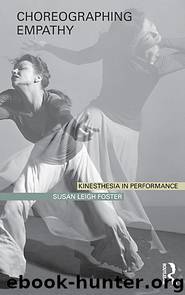Choreographing Empathy by Foster Susan Leigh

Author:Foster, Susan Leigh
Language: eng
Format: epub
Tags: Arts
Publisher: Taylor & Francis
Published: 2010-10-31T16:00:00+00:00
regulated spaces of the ballroom, however, the potential for too much excitement threatened the dancer’s stability and status. And worse, it intimated the onset of disease or even death. As one observer noted, the over-crowded conditions and excessive activity produced the same nefarious effects as those witnessed at “the black hole in Calcutta.”94
As masculine and feminine roles became increasingly polarized, emotions of all kinds and affect in general were relocated into the domestic sphere.95 The organization of the woman’s constitution around reproduction inclined her to self-sacrifice and domestic duties. The excessive delicacy of her nervous system also made her more susceptible to her own feelings and to those of others.96 Men’s capacity for abstract reasoning justified their regulation of social and political economies, whereas women’s ability to apprehend aesthetic achievement and to exercise imagination enabled them to interpret the social distress and plight of the less fortunate. Thus sympathy became sequestered within the feminine psyche in the same way that race and gender became specified through bone-deep differences in anatomical structure.
As sympathy was mobilized within this highly delimited arena, it provoked a series of contradictions. The delicacy of women’s nerves intimated an instability and an uncontrollability that lurked beneath the domestic serenity that woman was intended to promote within the private sphere.97 In the same way that dancing had the capacity to improve women through its moderation, but equally, the ability to produce excessive unruliness, so too, the anatomy of sympathy endowed it with a dual potential. As women were invited through literature or in charitable acts to witness the alterity of another’s suffering, they both identified and non-identified with their plight. Audrey Jaffe observes that the trope of sympathy across a range of literary projects entailed the “horror” of becoming the other, and hence a “fall” from one’s own position, that in turn, provoked a
Figure 3.5 In this illustration of Fanny Ellsler performing La Cachucha, it is clearly evident how the geometry of the ballet has infused the Spanish folk form with its emphasis on the linear shaping and proportion of the limbs.
Courtesy of The Lester S. Levy Collection of Sheet Music, Sheridan Libraries, The Johns Hopkins University
Download
This site does not store any files on its server. We only index and link to content provided by other sites. Please contact the content providers to delete copyright contents if any and email us, we'll remove relevant links or contents immediately.
Call Me by Your Name by André Aciman(20432)
Ready Player One by Cline Ernest(14574)
How to Be a Bawse: A Guide to Conquering Life by Lilly Singh(7436)
Wiseguy by Nicholas Pileggi(5708)
The Kite Runner by Khaled Hosseini(5133)
On Writing A Memoir of the Craft by Stephen King(4892)
Audition by Ryu Murakami(4888)
The Crown by Robert Lacey(4761)
Call me by your name by Andre Aciman(4646)
Gerald's Game by Stephen King(4609)
Harry Potter and the Cursed Child: The Journey by Harry Potter Theatrical Productions(4467)
Dialogue by Robert McKee(4353)
The Perils of Being Moderately Famous by Soha Ali Khan(4194)
Dynamic Alignment Through Imagery by Eric Franklin(4176)
Apollo 8 by Jeffrey Kluger(3667)
Seriously... I'm Kidding by Ellen DeGeneres(3606)
The Inner Game of Tennis by W. Timothy Gallwey(3601)
How to be Champion: My Autobiography by Sarah Millican(3571)
Darker by E L James(3492)
